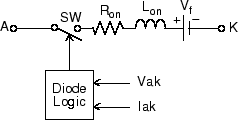Diode
다이오드 모델 구현
라이브러리:
Simscape /
Electrical /
Specialized Power Systems /
Power Electronics
설명
다이오드는 자체 전압 Vak와 자체 전류 Iak에 의해 제어되는 반도체 소자입니다. 다이오드가 순방향 바이어스 상태인 경우(Vak > 0), 다이오드에 작은 순방향 전압 Vf로 전류가 흐르기 시작합니다. 다이오드는 소자로 들어가는 전류 흐름이 0이 되면 꺼집니다. 반대로, 역방향 바이어스 상태인 경우(Vak < 0), 다이오드는 꺼진 상태를 유지합니다.
Diode 블록은 스위치와 직렬로 연결된 저항기, 인덕터, DC 전압원으로 시뮬레이션됩니다. 스위치의 동작은 전압 Vak와 전류 Iak에 의해 제어됩니다.

또한 Diode 블록에는 다이오드 소자와 병렬로 연결(노드 A와 K 사이)할 수 있는 직렬 Rs-Cs 스너버 회로가 포함되어 있습니다.
예제
power_diode 예제는 Diode 블록, RL 부하, AC Voltage Source 블록으로 구성된 단일 펄스 정류기를 보여줍니다.
가정 및 제한 사항
Diode 블록은 다이오드 소자의 매크로 모델을 구현합니다. 이 블록에서는 소자의 기하학적 구조나 상태 변화와 관련된 복잡한 물리적 과정을 고려하지 않습니다[1]. 차단 상태에서의 누설 전류와 역회복(음수) 전류는 고려하지 않습니다. 대부분의 회로에서 역전류는 컨버터나 기타 장치의 특성에 영향을 미치지 않습니다.
다이오드는 인덕턴스 Lon의 값에 따라 전류원(Lon > 0) 또는 가변 토폴로지 회로(Lon = 0)로 모델링됩니다. 스너버 회로를 사용하지 않으면 Diode 블록은 인덕터, 전류원 또는 개방 회로와 직렬로 연결할 수 없습니다.
회로를 이산화하는 경우에는 인덕턴스 Lon이 0으로 강제 설정됩니다.
포트
출력
보존
파라미터
참고 문헌
[1] Rajagopalan, V., Computer-Aided Analysis of Power Electronic Systems, Marcel Dekker, Inc., New York, 1987.
[2] Mohan, N., T.M. Undeland, and W.P. Robbins, Power Electronics: Converters, Applications, and Design, John Wiley & Sons, Inc., New York, 1995.
확장 기능
버전 내역
R2006a 이전에 개발됨
